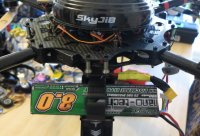Bartman
Welcome to MultiRotorForums.com!!
Hi everyone,
I've got a coaxial quad build in the works and I'm looking at my as-yet-unused APM 2.5+ as the FC for it but I don't know what the power module can handle in the way of max current.
Looking at it it looks like it goes inline between the batteries and the ESC's. It only has 13 awg wire though and I'm thinking I wouldn't want to put power for eight motors through that.
Thanks,
Bart
I've got a coaxial quad build in the works and I'm looking at my as-yet-unused APM 2.5+ as the FC for it but I don't know what the power module can handle in the way of max current.
Looking at it it looks like it goes inline between the batteries and the ESC's. It only has 13 awg wire though and I'm thinking I wouldn't want to put power for eight motors through that.
Thanks,
Bart

